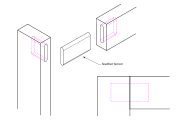- Mortise and tenon
-
The mortise and tenon joint has been used for thousands of years by woodworkers around the world to join pieces of wood, mainly when the adjoining pieces connect at an angle of 90°. In its basic form it is both simple and strong. Although there are many joint variations, the basic mortise and tenon comprises two components: the mortise hole (female) and the tenon (male). The tenon, formed on the end of a member generally referred to as a rail, is inserted into a square or rectangular hole cut into the corresponding member. The tenon is cut to fit the mortise hole exactly and usually has shoulders that seat when the joint fully enters the mortise hole. The joint may be glued, pinned, or wedged to lock it in place.
This joint is also used with other materials. For example, it is a traditional method for stonemasons and blacksmiths.
Contents
Types of mortise and tenon
A mortise is a cavity cut into a timber to receive a tenon. There are several kinds of mortises,[1]:
- Open mortise – a mortise that has only three sides. (See bridle joint).
- Stub mortise – a shallow mortise, in which depth depends on the size of the timber; also a mortise that does not go through the workpiece (as opposed to a "through mortise").
- Through mortise – a mortise that passes entirely through a piece.
- Wedged half-dovetail – a mortise in which the back is wider, or taller, than the front, or opening. The space for the wedge initially allows room for the tenon to be inserted; the presence of the wedge, after the tenon has been engaged, prevents its withdrawal. It is sometimes called a "suicide" joint, since it is a "one-way trip".
- Through wedged half-dovetail – a wedged half-dovetail mortise that passes entirely through the piece.
A tenon is a projection on the end of a timber for insertion into a mortise. Usually the tenon is taller than it is wide.There are several kinds of tenons:
- Stub tenon - a short tenon; depth depends on the size of the timber; also a tenon that is shorter than the width of the mortised piece so the tenon does not show (as opposed to a "through tenon").
- Tusk tenon - a kind of mortise and tenon joint that uses a wedge-shaped key to hold the joint together.
- Through tenon - a tenon that passes entirely through the piece of wood it is inserted into, being clearly visible on the back side.
- Biscuit tenon - a thin oval shape piece of wood, looks like a biscuit [3]
- Teasel tenon - a term used for the tenon on top of a jowled or gunstock post, which is typically received by the mortise in the underside of a tie beam. A common element of the English tying joint.
- Top tenon - the tenon that occurs on top of a post.
- Feather tenon - a round-shouldered machined fillet or feather which is glued into a machine (router) made slot or mortise on each side of the joint.
- Hammer-headed tenon - a method of forming a tenon joint when the shoulders cannot be tightened with a clamp.
- Half shoulder tenon- An asymmetric tenon with a shoulder on one side only. A common use is in framed, ledged and braced doors.
Generally the size of the mortise and tenon is related to the thickness of the timbers. It is considered good practice to proportion the tenon as one third the thickness of the rail, or as close to this as is practical. The haunch, the cut-away part of a sash corner joint that prevents the tenon coming loose, is one third the length of the tenon and one sixth of the width of the tenon in its depth. The remaining two-thirds of the rail, the tenon shoulders, help to counteract lateral forces that might tweak the tenon from the mortise, contributing to its strength. These also serve to hide imperfections in the opening of the mortise.
Gallery
- Various mortises
History
This is an ancient joint and has been found joining the wooden planks of the "Khufu ship",[2] a 43.6 m long vessel sealed into a pit in the Giza pyramid complex of the Fourth Dynasty around 2500 BC. Evidence of these joints has also been found in the 4800 year-old wooden ruins some archaeologists are calling "Noah's Ark" in Ankara.[3]
It has also been found in archaeological sites in the Middle East, Europe and Asia. In traditional Chinese architecture, wood components such as beams, brackets, roof frames and struts were made to interlock with perfect fit, without using fasteners or glues, enabling the wood to expand and contract according to humidity.[4] Archaeological evidence from Chinese sites shows that by the end of the Neolithic, mortise and tenon joinery was employed in Chinese construction.[5]
The thirty sarsen stones of Stonehenge were dressed and fashioned with mortise and tenon joints before they were erected between 2600 and 2400 BC.
References
- ^ "Mortise and Tenon Frame Joints", WoodworkDetails.com
- ^ Ward, Cheryl. "World's Oldest Planked Boats," in Archaeology (Volume 54, Number 3, May/June 2001). Archaeological Institute of America, [1].
- ^ News Article: Has Noah's Ark Been Found on Turkish Mountaintop? [2]
- ^ Steinhardt, Nancy W. (2002). Chinese Architecture (English Ed. ed.). Yale University Press. pp. 1. ISBN 0-300-09559-7.
- ^ Xujie, Liu (2002). Chinese Architecture - The Origins of Chinese Architecture (English Ed. ed.). Yale University Press. pp. 11. ISBN 0-300-09559-7.
- This article is partly based on a Quicksilver wiki article at A Glossary of Terms For Traditional Timber Framing (Timberbee) under the terms of the GNU Free Documentation License.
See also
External links
- DIYinfo.org's Timber Joints Wiki - Heaps of practical information on various types of timber joints.
Categories:
Wikimedia Foundation. 2010.







